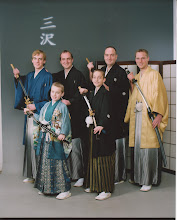Here is an essay I wrote on Shintoism...the research was kind of mind boggling, and I'm not sure everything translated right, but here it is. Part I
Shinto
All peoples of all nations and all times have, or have had, a worldview. A worldview is the lenses through which someone sees the world. All worldviews attempt to answer several fundamental questions about our very existence: What is the nature of God? What is the nature of man? And what is the universe? From these, several more questions arise: What is truth? What is morality? And what is family? These questions form the foundation to any worldview. The worldview that we will be looking at specifically is Shintoism. Shintoism and Buddhism are very intermixed and hard to separate. When I say that Shinto’s believe something, be aware that Buddhists’ also believe something similar. However, for the sake of simplicity, I will say that the Shinto’s believe something and exclude the Buddhists’.
Shintoism doesn’t have a monotheistic God, they are polytheistic. It is a complex mix of animism, ancestral worship, and worship of Kami. Kami, when translated, is the rough equivalent of spirits, natural forces, or essence. Everything has Kami; the birds, the rocks, the trees, people, the mountains, the ocean, and anything else you can think of. It all has a spirit. That is how animism fits into all of this; animism being the belief that all things have a soul. Nature, we must then conclude, is alive. If all things have Kami, then nature and mankind are inseparable, they’re equal. When a person dies, the family worships that person’s Kami to appease the Kami so it won’t cause trouble for the living. In reality then, worshiping the Kami is the same as worshiping your deceased ancestors. When you do something that harms nature, you offer a special prayer to placate the Kami.
At the ground breaking ceremonies for whatever is being built, a Shinto priest is there to bless and to pray to the Kami of the ground so it won’t be angry at the builders. An interesting fact about Shintoism is what they believe about babies. Shrines are dedicated to a child’s Kami who dies before birth, be it a miscarriage or an abortion because the baby’s Kami is thought to seek revenge and cause plagues and troubles for the living. The Shinto’s recognize that the unborn child is a living being, and that is why they take such care to try and appease the Kami of the baby. Shinto’s take much reverence if they are killing something to further their own well being, because they don’t want the Kami of whatever they killed to seek vengeance.
Shintoism is polytheistic. They have deities, the chief deity being Amatersasu, the sun goddess. Shintoism is a religion of brightness, at least to them it is, and that is why the sun goddess is so important to them. The Japanese national flag is a rising sun, in honor of the sun goddess.
A common factor to all worldviews is that they offer a creation story. How did we get here? Shintoism offers that the myriad of deities told two of their own to create a land for them to live on. Izanagi-no-Mikoto (male) and Izanami-no-Mikoto (female) then dipped a spear in the sea from the heavens and pulled it out of the water. The drops that fell from the spear tip formed land, the island of Japan. The deities then dwelt on the island. But then the two creators of the land, Izanangi-no-Mikoto and Izanami-no-mikoto, wanted offspring. They then engaged in a sacred ceremony, but they did it wrong and the following offspring (islands) were cast away. When tried again the offspring (islands) were perfect and so they kept them.
This is very important to the Shinto’s belief. Japan was created for the gods and goddess’, making it sacred. Some things are considered especially sacred: an unusual shaped rock or a tall tree. Mount Fuji is one of these places. At the top of Hakoda Mountain there is a small Shinto shrine.
Finding the difference between what is holy and what is the universe is very difficult with Shintoism. The Kami are worshipped, and all things have Kami, thus the universe is god.
All peoples of all nations and all times have, or have had, a worldview. A worldview is the lenses through which someone sees the world. All worldviews attempt to answer several fundamental questions about our very existence: What is the nature of God? What is the nature of man? And what is the universe? From these, several more questions arise: What is truth? What is morality? And what is family? These questions form the foundation to any worldview. The worldview that we will be looking at specifically is Shintoism. Shintoism and Buddhism are very intermixed and hard to separate. When I say that Shinto’s believe something, be aware that Buddhists’ also believe something similar. However, for the sake of simplicity, I will say that the Shinto’s believe something and exclude the Buddhists’.
Shintoism doesn’t have a monotheistic God, they are polytheistic. It is a complex mix of animism, ancestral worship, and worship of Kami. Kami, when translated, is the rough equivalent of spirits, natural forces, or essence. Everything has Kami; the birds, the rocks, the trees, people, the mountains, the ocean, and anything else you can think of. It all has a spirit. That is how animism fits into all of this; animism being the belief that all things have a soul. Nature, we must then conclude, is alive. If all things have Kami, then nature and mankind are inseparable, they’re equal. When a person dies, the family worships that person’s Kami to appease the Kami so it won’t cause trouble for the living. In reality then, worshiping the Kami is the same as worshiping your deceased ancestors. When you do something that harms nature, you offer a special prayer to placate the Kami.
At the ground breaking ceremonies for whatever is being built, a Shinto priest is there to bless and to pray to the Kami of the ground so it won’t be angry at the builders. An interesting fact about Shintoism is what they believe about babies. Shrines are dedicated to a child’s Kami who dies before birth, be it a miscarriage or an abortion because the baby’s Kami is thought to seek revenge and cause plagues and troubles for the living. The Shinto’s recognize that the unborn child is a living being, and that is why they take such care to try and appease the Kami of the baby. Shinto’s take much reverence if they are killing something to further their own well being, because they don’t want the Kami of whatever they killed to seek vengeance.
Shintoism is polytheistic. They have deities, the chief deity being Amatersasu, the sun goddess. Shintoism is a religion of brightness, at least to them it is, and that is why the sun goddess is so important to them. The Japanese national flag is a rising sun, in honor of the sun goddess.
A common factor to all worldviews is that they offer a creation story. How did we get here? Shintoism offers that the myriad of deities told two of their own to create a land for them to live on. Izanagi-no-Mikoto (male) and Izanami-no-Mikoto (female) then dipped a spear in the sea from the heavens and pulled it out of the water. The drops that fell from the spear tip formed land, the island of Japan. The deities then dwelt on the island. But then the two creators of the land, Izanangi-no-Mikoto and Izanami-no-mikoto, wanted offspring. They then engaged in a sacred ceremony, but they did it wrong and the following offspring (islands) were cast away. When tried again the offspring (islands) were perfect and so they kept them.
This is very important to the Shinto’s belief. Japan was created for the gods and goddess’, making it sacred. Some things are considered especially sacred: an unusual shaped rock or a tall tree. Mount Fuji is one of these places. At the top of Hakoda Mountain there is a small Shinto shrine.
Finding the difference between what is holy and what is the universe is very difficult with Shintoism. The Kami are worshipped, and all things have Kami, thus the universe is god.









2 comments:
Jared
Good job on the paper! You will probably need to insert the sources for your info when you hand it off to mom for a grade, though.
Love you
Keep at it. :)
Thanks!
Post a Comment